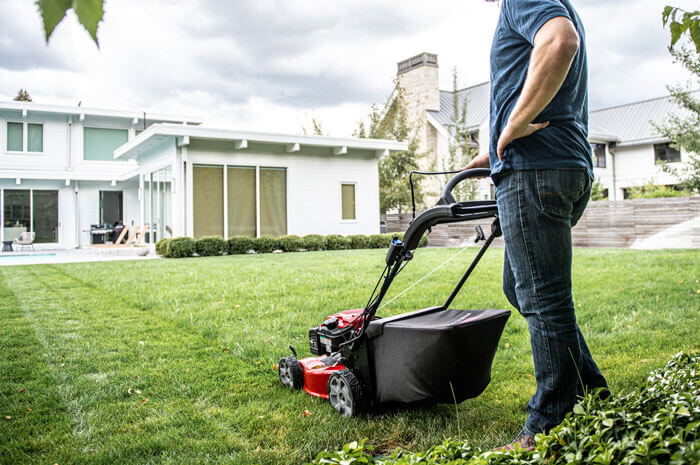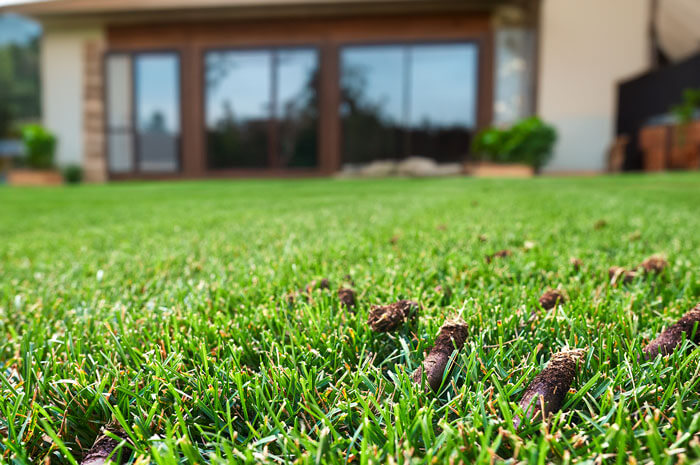
Finding the Right Walk-Behind, Self-Propelled Lawn Mower
One day, you may find yourself at the hardware store or home garden center, staring at the towering wall of walk-behind lawn mowers looking for the best option. Each all shiny and new, and nothing like that loud, oil-dripping, smoky beast you have in the back of your garage. But if you’re ready for a new push mower, do you know which is right for you and your yard? More than likely, you’ll want one that helps get the job done easier — like a self-propelled lawn mower.
So, let’s take a closer look at what to look for when choosing a self-propelled lawn mower.
How Does a Self-Propelled Lawn Mower Work?
Self-propelled lawn mowers are engineered to help move themselves, so seeing the designation when shopping means a person who buys that model won’t have to exert as much physical effort while mowing. Most of this class of push mowers adjust to the user without knobs, levers, or having to make any manual adjustments.
Think of a self-propelled lawn mower as a fuel-injected car. Its wheels automatically propel the mower down the lawn with less physical effort needed from the operator. You’ll like this if you have a huge yard, or one that is hilly or has rough terrain. With a self-propel system like Toro’s Personal Pace Auto-Drive System, it’s even more effortless and intuitively matches your walking pace by the amount of pressure you apply to the handle. Lean the handle forward to go faster, let up to slow the pace, and say goodbye to being dragged around the yard by your mower.
When looking at a push, self-propelled, or even electric lawn mower, it all comes down to a few key things:
Drive Options: front-wheel, rear-wheel, or all-wheel drive
Cutting Options: mulch or not
Mower Model: mow, mulch and bag, or just mow and bag
Wheel Size: low or high wheel
Engine Output: gas-powered versus electric
Convenience features: electric-start, ease of use, comfort
Let’s start from the top to show you everything that goes into a self-propelled lawn mower.
Drive Options
Front-Wheel, Rear-Wheel, or All-Wheel Drive — What’s the Difference?
Front- and rear-wheel drive mowers use a belt-and-pulley system to throw direct power from the engine to the front or rear axles to drive it forward. All-wheel drive mowers give added traction by powering all four wheels equally at once — making it ideal for yards with steeper slopes, uneven terrain, or just difficult mowing conditions.
Another type of transmission you can find is hydrostatic. Hydrostatic transmissions flow hydraulic fluid past the impeller that controls ground speed. It’s the smoothest and more reliable transmission, but it’s also the most expensive.
If you have a more complex landscape, look at front-wheel lawn mowers. You’ll be better able to tilt the lawn mower up when you want to stop its movement or change direction. That said, some rear-wheel drive lawn mowers also allow you to easily disengage the self-propel feature.
If you plan on bagging your grass clippings, look at a rear-wheel drive model. It puts more weight on the back wheels and gives better traction. Rear-wheel also enables you to mow in a straight line easier.
Cutting Options
To Mulch, or Not to Mulch?
How much work do you want to do? A mower with a mulching blade, like a Recycler, cuts grass into tiny pieces that break down and decompose easily — putting important nutrients back to your yard. For supercharged mulching performance, look for a model with an intake system that fuels the cutting chamber with additional airflow.
Bagging your grass clippings could make your yard look cleaner, but takes more effort to bag or rake up and dispose. You’ll want to see if your town or municipality even picks up yard waste, or if you’ll need to bring it to a compost center.
Mower Model Options
3-in-1. 2-in-1. What-in-the-What?
Mowing isn’t really a numbers game, it just thinks it is. A 3-in-1 mower lets you mow, mulch and bag in one machine. 2-in-1 mowers either mulch and bag, or mulch and side discharge.
Most mowers let you quickly and easily switch between ways. If you want to bag your grass clippings, look at a rear-bagging model. It holds more than those with side-discharge bags.
Wheel Size
Do Low or High Wheels Matter?
Low-wheel lawn mowers have the same size wheels in the front and back. These are fine for your typical flat yard.
High wheels are best for bumpy or difficult terrain. With large wheels in the back, you can go over any terrain with ease. A high-wheeled model might cost a little more, but it’s worth it if needed. Typically, the cost difference is very minimal anyway.
Engine Output
What’s the Difference Between a 2-Cycle and 4-Cycle Engine?
Two-cycle engines require mixing oil and gas. This is probably that old beast you have hidden in your garage or garden shed. It’s loud, dirty, and outdated. If this is your lawn mower, it’s time to move on. Four-cycle engines are more powerful, quieter and efficient.
What About Electric Lawn Mowers?
Instead of gas engines, electric lawn mowers feature powerful lithium-ion batteries that last around 45 minutes per charge. For most homeowners, that’s enough time to mow up to about a third of an acre before having to recharge or change batteries.
With an electric mower, you’ll never worry about buying gas, replacing oil, or making your neighbors angry during their family barbecue. Like gas-powered models, some are even self-propelled. Plus, many lithium-ion lawn mowers are a part of a tool family, like Toro’s 60V Flex-Force Power System, that all run on an interchangeable battery that you can use with the other tools in the platform, too!
When it Comes to Cutting Tall Grass, Muscle Matters
Self-propelled mowers typically come in engine sizes of 140cc to 190cc. Those with the larger engine have more torque — which will have you ripping through overgrown yards with ease and with no worry of stalling. That extra torque also gets self-propelled mowers up hills more effectively.
Convenience and Ease
To Make Mowing More Enjoyable, Look for Features That Make it Easier:
Key or Button Start: A quick turn of the key or press of a button cranks it up, without you cranking out your back trying to pull-start your mower.
Quick-Adjust Wheels: Look for wheels that can be easily raised or lowered with a simple single-lever deck adjustment.
Handlebar Height: See if your handlebars adjust to different heights — something to consider if you switch lawn-mowing duties in your household.
Save Space: Some mower handlebars collapse onto the unit, some can even be stowed upright, like mowers with SmartStow Technology, helping you store it in smaller spaces.
Ground Speed Control: Self-propelled mowers can be great, but are they too fast for you? Look for a control bail where you can control the speed based on your grip.
Focus on Comfort:
Before you buy, hold the handlebar. Give it a push in the store. Press down on the control bail — the lever that makes it go. How does it feel? Too stiff? Just right? Purchase the machine that feels the most comfortable. That’s the best self-propelled lawn mower for you. You’ll be spending a lot of time with it throughout the years, so you may as well enjoy it right from the start.
When it comes to purchasing your next lawn mower, there are a lot of options for you to choose — from gas-powered to lithium-ion-battery powered, push to self-propelled to riding mowers. When you know what to look for, and understand what’s needed for your yard, you’ll soon know how to pick a lawn mower that works for you.
Ready to shop? Visit Toro.com to learn about our walk-behind lawn mowers. Backed by over a century of product innovation, we offer a wide range of high-quality self-propelled lawn mowers to ensure the best fit for your needs and budget.



